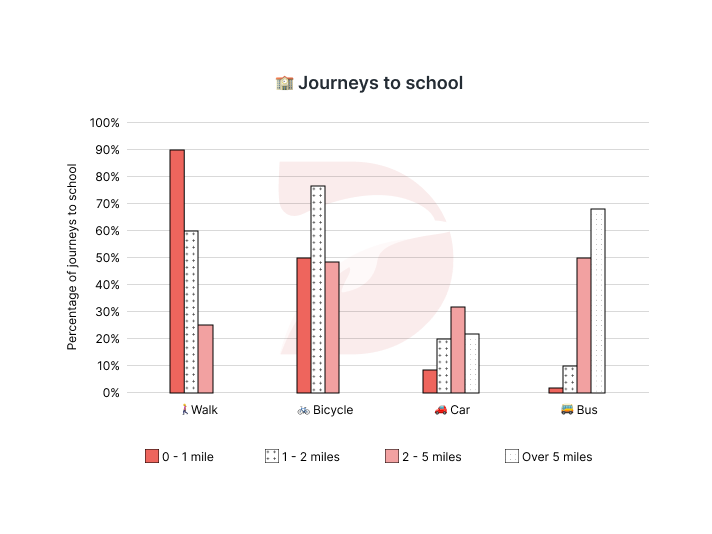Đề thi IELTS Writing Task 1 ngày 13/04/2024 kèm bài mẫu band 8
Đề thi IELTS Writing Task 1 ngày 13/04/2024 dạng Bar chart: The chart below gives information about the journeys to school by children aged 11 to 16 in the UK in a year. Summarise the information by selecting and reporting the main features, and make comparisons where relevant.
🚀 Đề bài

😵 Dàn ý
DOL sẽ miêu tả biểu đồ với 1 câu mở bài (Intro), 1 đoạn miêu tả tổng quát (Overview), và 2 đoạn thân bài miêu tả chi tiết (Detailed Description)
Mở bài: DOL sẽ paraphrase đề bài để giới thiệu lại đề bài cho người chấm.
Miêu tả tổng quát: DOL sẽ chỉ ra các đặc điểm quan trọng, nổi bật nhất trong biểu đồ.
Thân bài:
Body 1: DOL mô tả phần trăm học sinh chọn các hình thức đi lại trong khoảng cách dưới 1 dặm và từ 1-2 dặm.
Body 2: DOL mô tả phần trăm học sinh chọn các hình thức đi lại trong khoảng cách từ 2-5 dặm và trên 5 dặm.
- Walking: 90%;
- >> surpass bicycles by 40%;
- Cars and buses: less favored (< 10%).
- Cycling:most popular (~75%);
- Walking: 60% = 3x cars and 6x buses.
- Buses took the lead (50%);
- >> closely followed by bicycles (47%);
- Cars and walking: third and fourth place (31% and 25%).
- Buses: remained the preferred choice (70%);
- >> followed by cars (21%);
- >< walking and cycling: be not chosen.
📝 Bài mẫu
The bar chart
Overall, the majority of children chose to walk or cycle for journeys that were 2 miles or shorter while buses were the most common options for those who traveled longer distances.
Regarding commutes under 1 mile, walking
Concerning journeys within the 2-to-5-mile range, buses took the lead with 50%, closely
(194 words)
📚 Vocabulary
✨ Bài tập Exercise
Mình cùng làm 2 bài tập sau đây để ôn lại các từ vựng và cấu trúc đã được dùng trong bài mẫu IELTS Writing Task 1 nhé!
Exercise 1: Điền từ / cụm từ phù hợp vào chỗ trống.
1 Biểu đồ minh họa mối quan hệ giữa thu nhập và hạnh phúc.
-> The graph
2 Tôi đi làm bằng tàu hỏa hàng ngày.
-> I
3 Các khu vực đô thị chiếm 70% mức tiêu thụ năng lượng của thế giới.
-> Urban areas
4 Thành tích của vận động viên năm nay vượt qua mọi kỷ lục trước đó trong môn thể thao này.
-> The athlete's performance this year
5 Điện thoại thông minh mới đã nổi lên như một sự lựa chọn phổ biến nhất của người tiêu dùng.
-> The new smartphone has
Phân tích đề IELTS Writing Task 2 band 8 ngày 13/04/2024 và từ vựng cần nhớ!
Exercise 2: Điền từ vào chỗ trống (dựa vào những gợi ý có sẳn)
chiếm
khoảng
theo sau
lần lượt/tương ứng
lựa chọn ưa thích
Tuyển chọn đề thi tháng 14/2024 và bài mẫu chi tiết.
💡 Lời kết
Tới đây là hết rồi  Sau sample "The chart below gives information about the journeys to school by children aged 11 to 16 in the UK in a year. Summarise the information by selecting and reporting the main features, and make comparisons where relevant.", DOL mong các bạn không chỉ nắm được cách trả lời cho dạng bài Bar chart, mà còn học được những từ vựng và cấu trúc hay để miêu tả các biểu đồ tương tự nhé.
Sau sample "The chart below gives information about the journeys to school by children aged 11 to 16 in the UK in a year. Summarise the information by selecting and reporting the main features, and make comparisons where relevant.", DOL mong các bạn không chỉ nắm được cách trả lời cho dạng bài Bar chart, mà còn học được những từ vựng và cấu trúc hay để miêu tả các biểu đồ tương tự nhé.
1. Sử dụng cấu trúc tương phản với "while"
- Cấu trúc: SV while SV
- Ví dụ: The majority of children chose to walk or cycle for journeys that were 2 miles or shorter while buses were the most common options for those who traveled longer distances.
-> Chức năng: 2 mệnh đề SV 2 bên "while" mang nét nghĩa tương phản/khác nhau.
-> Trong câu này, học sinh chọn đi bộ hoặc xe đạp cho đoạn đường 2 dặm hoặc ngắn hơn # chọn xe buýt cho đoạn đường dài hơn.
2. Mệnh đề quan hệ rút gọn
- Cấu trúc: SV1, which V2 => SV1, V2-ing
- Ví dụ: Walking accounted for 90% of such journeys, surpassing the figure for bicycles by 40%
3. Cách dùng "by" + data
- Cách dùng: data ở đây là một khoảng chênh lệch giữa 2 số liệu.
- Ví dụ: Walking accounted for 90% of such journeys, surpassing the figure for bicycles by 40%.
-> Giải thích: Walking (90%) - bicycles (50%) = 40%
Nếu có thời gian thì nhớ làm phần bài tập và tự mình viết một bài khác nha vì 'Practice makes perfect' mà nhỉ? DOL chúc các bạn học tốt!


